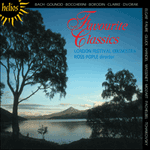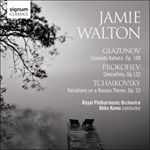
Welcome to Hyperion Records, an independent British classical label devoted to presenting high-quality recordings of music of all styles and from all periods from the twelfth century to the twenty-first.
Hyperion offers both CDs, and downloads in a number of formats. The site is also available in several languages.
Please use the dropdown buttons to set your preferred options, or use the checkbox to accept the defaults.


‘Rêverie du soir’ instantly captures the moods of languor, longing and resignation, which, thanks to countless poems, songs and films, are thought of as archetypal for the Russian soul. The middle section’s major mode promises more activity, but the tempo is explicitly marked to be the same, and sighing articulations ensure that there is still a watery film over the eyes. The fleetness and dexterity required by the ‘Scherzo humoristique’ are tempered by grazioso markings that remind us of the affinities of Tchaikovsky’s expressive world with the ballet. The same is true of the chimes at the heart of the slower central section, which would not be out place in The Nutcracker.
More within the reach of amateurs is the ‘Feuillet d’album’ (‘Album leaf’), marked Allegretto simplice, which seems to come straight from a world of domestic story-telling. Andante sentimentale may be the marking for the ‘Nocturne’; but this too is more of a personal confession than an overt, public declaration, and the tone feels more warm-hearted than self-pitying. The ‘Nocturne’ was the most popular of the collection in its day, and in 1888 Tchaikovsky himself made a transcription of it for cello and orchestra.
The penultimate piece starts intimately and even-temperedly, somewhat curiously for an idea that was supposed to be part of a symphony (never realized as such). Just as it seems to be sinking into slumber, however, a bustling Allegro vivacissimo middle section shows that the ‘Capriccioso’ title is not accidental. The return to intimacy is not fundamentally disturbed by the fuller texturing of the material.
Dedicated to Hermann Laroche, music critic and essayist, and one of Tchaikovsky’s staunchest public supporters, the concluding ‘Thème original et variations’ is often heard as a self-sufficient concert piece, but it also makes a satisfying conclusion to the opus as a whole. The unassuming lyrical theme spawns variations that unfold its inner secrets at the same time as unobtrusively referring back to the textures and moods of the other pieces in the collection. The penultimate variation is marked Alla Schumann, perhaps because of its passing resemblance to the finale of Schumann’s Études symphoniques. However, there is little of the vaulting ambition of that work elsewhere in the variations. Both in the characters of each variation and in their succession—from the amorous No 5 to the mock-academic fugato in No 6, to the quasi-chorale of No 7, the boulder-tossing of No 8 and the Alla mazurka No 9—there is more playfulness and grace than anything profound or soul-searching. Even so, the overall affinity with Schumann, in terms of both piano-writing and emotional tenor, remains as unmistakable here as it is in The seasons.
from notes by David Fanning © 2014
«Rêverie du soir» saisit instantanément la langueur, la nostalgie et la résignation archétypiques—les innombrables poèmes, chansons et films nous le disent—de l’âme russe. Le mode majeur de la section centrale promet un regain d’activité, mais le tempo demeure explicitement le même et les articulations soupirantes affirment que les yeux sont encore embués de larmes. La vélocité et la dextérité requises par le «Scherzo humoristique» sont tempérées par les indications grazioso qui nous rappellent toute l’affinité de l’expressivité tchaïkovskienne pour le ballet. De même pour les carillons au cœur de la section centrale, qui ne dépareraient pas Casse-noisettes.
Davantage à la portée des amateurs, le «Feuillet d’album», marqué Allegretto simplice, semble tout droit sorti de l’univers des conteurs familiaux. Le «Nocturne» a beau être marqué Andante sentimentale, il tient plus de la confession intime que de la franche déclaration publique, sur un ton plus chaleureux qu’apitoyé. Ce «Nocturne» fut, en son temps, la pièce la plus populaire du recueil et, en 1888, Tchaïkovski le transcrivit pour violoncelle et orchestre.
L’avant-dernière pièce démarre dans une intimité et une équanimité plutôt curieuses pour une idée censée faire partie d’une symphonie (qui ne verra jamais le jour en tant que telle). Au moment même où elle paraît sombrer dans le sommeil, cependant, une section centrale active, marquée Allegro vivacissimo, nous prouve que le titre «Capriccioso» n’est pas là par hasard. Le retour à l’intimité n’est pas foncièrement perturbé par la texture plus pleine du matériau.
Dédié au critique musical et essayiste Hermann Laroche—l’un des plus fidèles défenseurs de Tchaïkovski en public—, le «Thème original et variations» conclusif est souvent entendu comme morceau de concert autonome, ce qui ne l’empêche pas de faire une conclusion d’une belle venue. Le thème lyrique sans prétention engendre des variations qui laissent apparaître ses secrets intimes, tout en renvoyant discrètement aux textures et aux climats des autres pièces du recueil. L’avant-dernière variation est marquée Alla Schumann, peut-être à cause de sa fugace ressemblance avec le finale des Études symphoniques schumanniennes, œuvre dont l’ambition démesurée ne trouve guère d’écho dans les autres variations. Dans leur caractère, dans leur manière de se succéder—de l’amoureuse nº 5 au fugato pseudo-académique de la nº 6, au quasi-choral de la nº 7, au roulement des galets de la nº 8 et à l’Alla mazurka de la nº 9—, ces variations affichent plus d’enjouement et de grâce que de profondeur et d’introspection. Pourtant, dans l’écriture pianistique comme dans la teneur émotionnelle, l’affinité avec Schumann demeure aussi patente que dans Les saisons.
extrait des notes rédigées par David Fanning © 2014
Français: Hypérion
Die „Rêverie du soir“ fängt sofort eine Stimmung der Trägheit, Sehnsucht und Resignation ein, die dank zahlloser Gedichte, Lieder und Filme als urtypische Charakteristika der russischen Seele betrachtet werden. Die Durtonalität des Mittelteils scheint mehr Lebhaftigkeit zu versprechen, doch wird der Interpret ausdrücklich dazu angewiesen, das Tempo gleich zu halten, und die seufzerartigen Figuren sorgen dafür, dass die Augen benetzt bleiben. Das „Scherzo humoristique“ verlangt Schnelligkeit und Geschick, was von den grazioso-Anweisungen etwas gemäßigt wird—das Ganze erinnert an die Parallelen zwischen dem Ballett und Tschaikowskys expressiver Welt. Dasselbe gilt für die Glockenschläge im langsameren Mittelteil, der ohne Weiteres in den Nussknacker eingefügt werden könnte.
Für Laien leichter zu meistern ist das „Feuillet d’album“ („Albumblatt“), das die Anweisung Allegretto simplice trägt und das der heimischen Sphäre des Geschichten-Erzählens zu entstammen scheint. Andante sentimentale mag zwar die Anweisung für das „Nocturne“ zu sein, doch handelt es sich auch hierbei eher um ein persönliches Bekenntnis als eine offensichtliche, öffentliche Erklärung, und der Ton ist eher warmherzig als selbstbemitleidend gehalten. Das „Nocturne“ war zu seiner Zeit das populärste Stück der Sammlung und 1888 arrangierte Tschaikowsky es selbst für Violoncello und Orchester.
Das vorletzte Werk beginnt in intimer und ausgeglichener Weise, was für ein Stück, das Teil einer Symphonie werden sollte etwas seltsam anmutet—allerdings wurde dieser Plan dann nicht verwirklicht. Just in dem Augenblick jedoch, wenn die Musik einzuschlummern scheint, wird durch einen geschäftigen Mittelteil, Allegro vivacissimo, deutlich, dass der Titel „Capriccioso“ nicht unabsichtlich gewählt ist. Die Rückkehr zur Intimität wird durch die dichtere Struktur des Materials nicht wesentlich gestört.
Der abschließende Satz, „Thème original et variations“, ist dem Musikkritiker und Essayisten Hermann Laroche gewidmet, einer der treuesten öffentlichen Anhänger Tschaikowskys. Oft ist dieser Satz als eigenständiges Konzertstück zu hören, doch bildet er auch einen sehr überzeugenden Abschluss zu diesem Opus. Das unaufdringliche lyrische Thema bringt Variationen hervor, die innere Geheimnisse enthüllen und gleichzeitig unauffällig auf die Texturen und Stimmungen der anderen Stücke der Sammlung Bezug nehmen. Die vorletzte Variation ist mit Alla Schumann überschrieben, möglicherweise aufgrund einer gewissen Ähnlichkeit mit dem Finale von Schumanns Symphonischen Etüden; anderswo in den Variationen findet sich der sprunghafte Gestus jenes Werks jedoch kaum. Die Variationen sind alle sowohl von ihrem Charakter als auch von ihrer Abfolge her—von der amourösen Nr. 5 über das pseudo-gelehrte Fugato in Nr. 6 bis hin zum quasi-Choral in Nr. 7, dem felsbrockenwerfenden Nr. 8 und der Nr. 9, Alla mazurka—nicht so sehr ein tiefgründiges Insichgehen, sondern eher spielerisch und anmutig gehalten. Trotzdem ist insgesamt die Ähnlichkeit zu Schumann, sowohl was den Klaviersatz als auch was die emotionale Grundhaltung anbelangt, hier ebenso unverkennbar wie in den Jahreszeiten.
aus dem Begleittext von David Fanning © 2014
Deutsch: Viola Scheffel
 Favourite Classics Favourite Classics‘This is indeed a CD with the most popular tunes in the classic repertoire’ (Interval) ‘As a CD to lift the spirits … it would be hard to beat’ (Contemporary Review)» More |
 Glazunov, Prokofiev & Tchaikovsky: Music for cello & orchestra Glazunov, Prokofiev & Tchaikovsky: Music for cello & orchestraStar British cellist Jamie Walton returns to Signum with a programme of Russian repertoire by Glazunov, Prokofiev and Tchaikovsky. Joined by the Royal Philharmonic Orchestra under Okko Kamu, the album includes the original version of Tchaikovsky’s ...» More |

